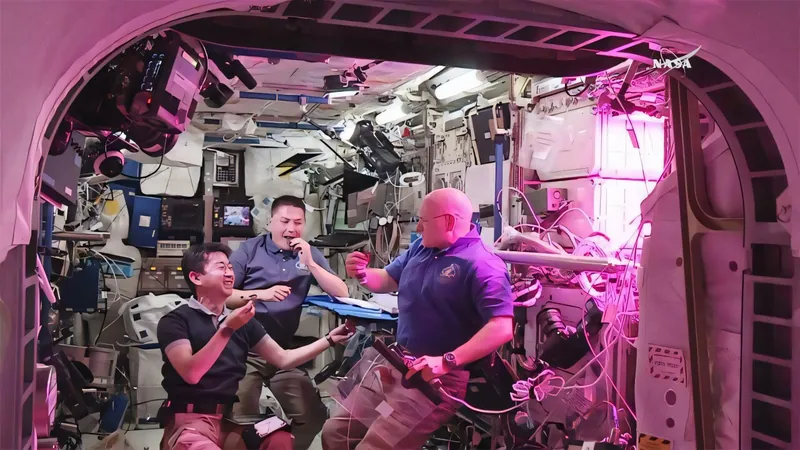
The Hidden Challenge of Astronaut Nutrition: Could It Derail Future Mars Missions?
2024-10-29
Author: John Tan
The Importance of Astronaut Nutrition
As humanity gears up for the inevitable crewed mission to Mars, it’s becoming increasingly evident that astronaut nutrition has emerged as a critical barrier to long-duration spaceflight. While astronauts already spend months aboard the International Space Station (ISS), the journey to Mars is a different beast altogether, where missions could last years without a chance for resupply.
Hazards in Space
Low gravity and intense radiation exposure are the two major hazards astronauts face while in orbit, contributing to muscle and bone density loss as well as increased cancer risks. For Mars missions, each segment of the trip can take as long as six to seven months, with potential stays on Mars lasting up to 500 days. To put this into perspective, that's a staggering contrast to the brief eight days Apollo 11 astronauts spent in space.
Research and Resources
NASA is currently undertaking significant research to understand how nutrition can play a role in ensuring astronaut health and mitigating the various risks during such extensive missions. A valuable resource in this endeavor is the newly released PDF book: "Human Adaptation to Spaceflight: The Role of Food and Nutrition—2nd Edition," authored by a team of experts in fields like biochemistry and space food systems.
Lessons from History
The authors emphasize that the history of exploration has repeatedly demonstrated the crucial role of nutrition. However, they highlight a stark difference: unlike past explorers, astronauts won’t have the opportunity to find food along their journey. Thus, the challenge of creating effective and sustainable food systems for long missions is as vital to crew safety as the mechanical systems of their spacecraft.
Unique Challenges
The book surveys unique challenges astronauts face, drawing parallels to research conducted in extreme environments such as Antarctica, where isolation and limited sunlight mimic the conditions of space travel. For instance, microgravity-induced muscle atrophy isn’t merely a theoretical construct; it has serious implications for astronauts’ health and physical functionality.
Lesser-Known Risks
Lesser-known risks also present significant concerns. Astronauts may suffer from neuro-ocular syndrome, weakened immune systems, changes in gut biota, and more—all of which are closely tied to nutrition. Despite ongoing research, gaps remain in our understanding of the relationship between nutrition and these health risks, underlining the urgent need for a robust nutritional support system.
Current Food Systems
Currently, astronauts on the ISS, those from nations other than Russia, receive a portion of their meals from Crew Specific Menu (CSM) containers, with about 10% to 20% of their food sourced this way. While they also have limited access to fresh produce during resupply missions, this variety pales compared to what’s readily available on Earth. Experimental "farming" initiatives aboard the ISS have produced vegetables like lettuce and kale, but this is far from ensuring nutritional sufficiency for a Mars mission.
Dietary Supplements
An increasingly pressing question surrounds the potential of dietary supplements to substitute for whole foods. Contrary to popular belief, evidence suggests that the intricate benefits of whole foods cannot be effectively replicated through supplements, and in some cases, they may even pose health risks, including amplifying cancer risks.
Psychological Aspects
Moreover, the psychological aspect of nutrition shouldn't be overlooked. Access to a diverse range of healthy foods significantly impacts astronauts' morale and can foster camaraderie among crew members, mirroring the social benefits of sharing meals with loved ones back on Earth.
The Urgency of Solutions
Despite the critical importance of developing a viable space food system, the authors of the study acknowledge there’s currently no established system capable of addressing the nutritional needs, safety protocols, and resource limitations for long-duration missions like those to Mars. The urgency to create such a system cannot be overstated; failure to do so jeopardizes not only the crew's well-being but the very success of future missions.
Conclusion
In conclusion, as we look toward a future among the stars, astronaut nutrition stands as not just a logistical hurdle but a fundamental element of mission design. Unless scientists and researchers can transform our understanding of space nutrition into practical solutions, the dreams of interplanetary travel may remain just that—dreams. The clock is ticking, and the answers must come soon if we are to make history on Mars. Will we rise to the occasion?



 Brasil (PT)
Brasil (PT)
 Canada (EN)
Canada (EN)
 Chile (ES)
Chile (ES)
 España (ES)
España (ES)
 France (FR)
France (FR)
 Hong Kong (EN)
Hong Kong (EN)
 Italia (IT)
Italia (IT)
 日本 (JA)
日本 (JA)
 Magyarország (HU)
Magyarország (HU)
 Norge (NO)
Norge (NO)
 Polska (PL)
Polska (PL)
 Schweiz (DE)
Schweiz (DE)
 Singapore (EN)
Singapore (EN)
 Sverige (SV)
Sverige (SV)
 Suomi (FI)
Suomi (FI)
 Türkiye (TR)
Türkiye (TR)